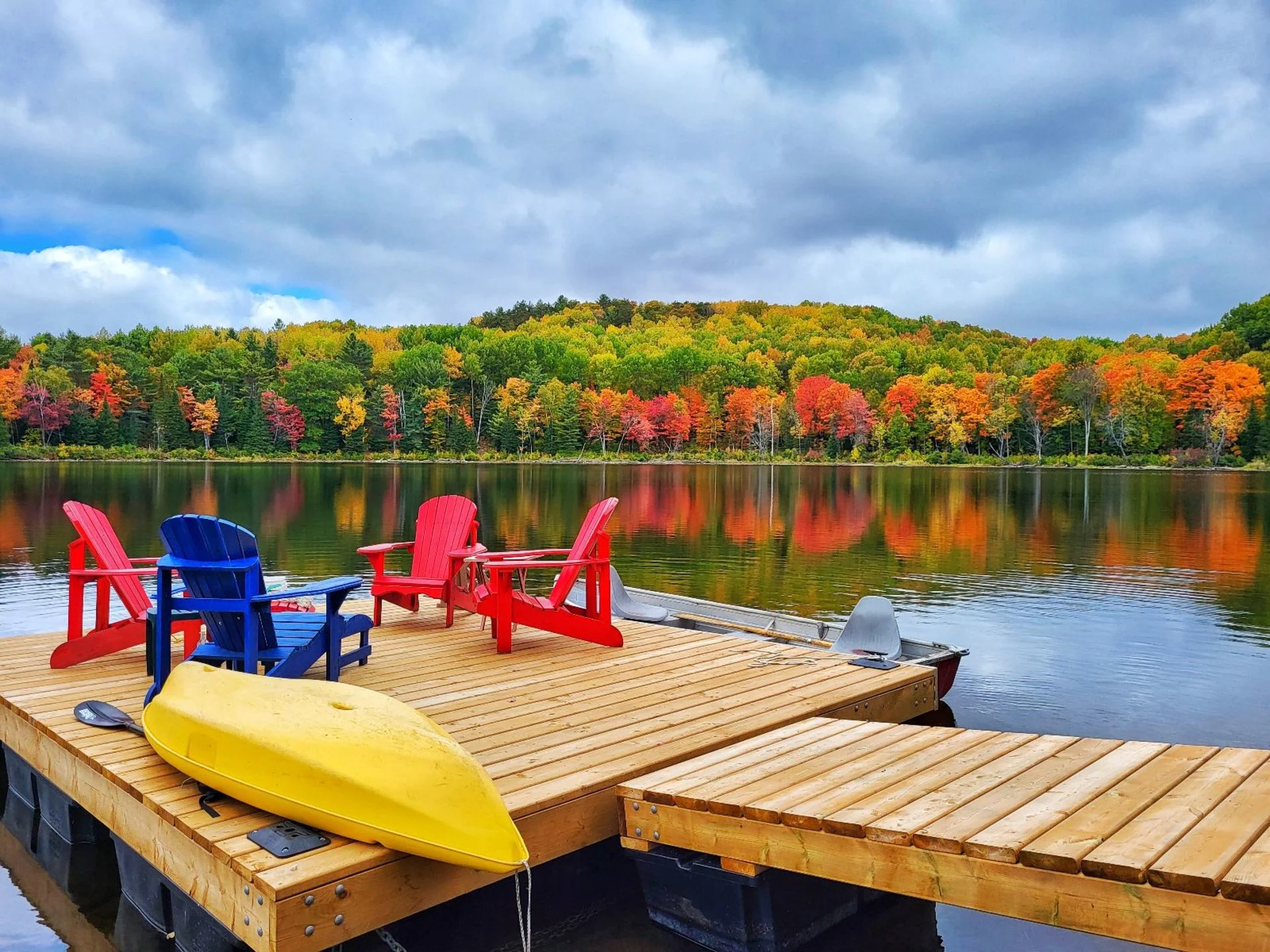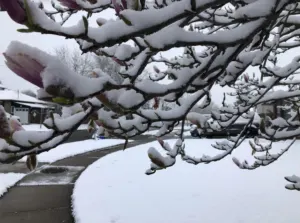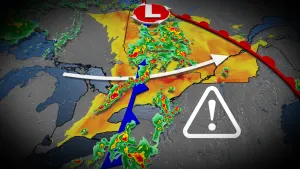
Weather partly to blame (or thank) for Canada's fall foliage variations
Fall is a transitional time for many reasons in Canada: From the clothes we wear and the drinks we like to consume...to the colours of the leaves. Humans and Mother Nature go through unique changes ahead of winter.
As the leaves change colour every fall, we are treated to beautiful views of our trees and landscapes.
During autumn, the colours will appear pretty dull before a metamorphosis makes the leaves look vibrant. Evolution is a delicate process.
When we talk about the colour-changing process in the fall, we have to understand that it is a procedure that is "highly regulated" by the trees, no matter what species they are, says Ingo Ensminger, biology professor and researcher with the University of Toronto Mississauga (UTM).
Visit our Complete Guide to Fall 2023 for an in-depth look at the Fall Forecast, tips to plan for it and much more!
The main triggers behind the change are temperatures and day length, which determine when the colours actually switch.
"The purpose of the changing colours is the tree is preparing for the winter season," Ensminger told The Weather Network in a recent interview. "The change in colour actually indicates that the tree starts to retrieve all the nutrients from the leaves, which means everything that is vaguely useful for the tree is broken down into smaller products."

(Scott/Submitted to The Weather Network)
After all the "nice colours have disappeared," what remains of the leaf is basically a skeleton of the tree, Ensminger said.
"The tree makes a lot of use of the environmental information like temperature and day length, and day length doesn't change at all," said Ensminger.
Late September or early October is when leaves 'typically' start to change colour
The fall colour season starts as early as August sometimes, but it's typically in late September and early October—like this year, says Megan Birrell, assistant program co-ordinator with Ontario Parks.
Despite the "atypical," warmer weather in Ontario earlier this fall, the province is experiencing a "pretty typical season" for the colour change, she noted.
"I remember hearing a lot last year that the colours were really vibrant. I'm not sure specifically why that was. But, I think this year has been awesome, as well," said Birrell.

(Kitty Yip/Submitted to The Weather Network)
“If you have that consistent temperature, you will see a longer fall colour period. That could be a week or more than a week. If we have [those] consistent warm days and cool nights, we will see a longer fall season,” said Birrell.
She stated that trees want to recoup the energy and resources they put into acquiring their leaves before the climate becomes too harsh for them to continue.
"Think of our cold winters. They are not ideal for leaves. After all, the leaves are what's making the food for the tree. Once those leaves are destroyed, the [trees aren't] so happy," said Birrell. "What they do instead is go dormant, [which] is how we see the fall colours change."
WATCH: Take in the spectacular fall foliage of these picturesque Ontario parks
Stages of transformation depends on tree type
Leaves will go through stages in the colour-change sequence.
During the summer, there comes a time when most trees "actually" sense a change is coming in the day length, triggering a series of initial steps for the colour modification, regardless of the temperature, Ensminger said.
"They use temperature in order to modulate the sequence of fall steps," he said.

(Unsplash)
In terms of timing and how long it takes, Birrell said it depends on the tree type.
"The different types of trees change colours at different times during the season and for different durations. Those iconic red maple leaves that we kind of look for every single year come earlier in the season," said Birrell. "They are really dependent on that time of day."
After those red and orange colours peak, we see leaves on trees such as birch, poplars and Tamarix change to a yellow-gold hue, typically after the maple leaf season, referred to as a golden encore, she said.
SEE ALSO: Why do leaves change colour in the fall?
"It's honestly an amazing sight, especially at Algonquin Park. It really depends on the type of tree, the variability in the weather, how consistent it is, and of course, the length of sunlight in the day," said Birrell.
And the time it takes for the leaves to fall onto the ground after changing colours depends on the weather, Birrell reiterated. Factors such as high winds and storms can accelerate leaf fall.

(Caroline/Submitted to The Weather Network)
"A leaf that hasn't even actually changed colour could fall off if we have a lot of wind and it really just depends on the season, the tree and the weather we've been experiencing," said Birrell.
Tracking the fall colour season
Canadians can typically find websites offering recommendations on where to go to view the peak fall colours.
In Ontario, to get a sense of where to go in the province to see the peak fall foliage, Ontario Parks has a progression map on its website.
“It makes booking your travel to see the fall colours a lot easier. That way, too, if you're planning to go somewhere for a day trip, and perhaps you're too late, the map will show you that leaves are past peak at this time, and there's a bit of a leaf fall," said Liisa Sefton, broadcast media specialist with Destination Ontario, in a recent interview with The Weather Network.

(Caroline/Submitted to The Weather Network)
Destination Ontario has a partnership with Ontario Parks. The former used to produce a fall colour report every year that referred to the progression map produced by the latter, but it is now obsolete.
"We use [the progression map] as a tool. It's a great partnership with Ontario parks, and a really good tool to use to plan your fall travel," said Sefton.
Does climate change factor into the foliage?
When mentioning climate change in the conversation on fall foliage, it is not as simple as it appears.
It's not a question of how climate change can actually affect leaf colours, Ensminger said, but rather, "how does temperature actually trigger and delay this autumn process to some extent?"
"The short answer to that is yes. If the falls are getting warmer, that will very likely delay the occurrence of the fall colours. This is what I think a lot of observations and a lot of studies already demonstrate," said Ensminger. "Warmer falls lead to a delay in the onset of the fall colours."

(Calvin Hanson Photos/Submitted to The Weather Network)
However, the UTM biology professor doesn't think that a warm autumn has any negative impact on the formation of fall colours because the sequence of events starts with the breakdown of chlorophyll -- the green leaf colour, which slowly degrades and then actually makes all the carotenoids visible.
"Carotenoids are the yellow and orange pigments in the leaf that are all [there] during the summer, and they only become visible in the fall when the chlorophylls have been broken down," said Ensminger. "It's not that they were late in the fall, like many people think, that they all of a sudden are being produced. They have only been masked by the chlorophylls to that point."
As a result, Ensminger doesn't think our changing climate will necessarily alter the sequence of the events.
WATCH: Stunning aerial of the leaves changing in Toronto
However, if the trees experience droughts or a very hot summer, what climate change will "probably do" is modify the fall schedule to a "much, much larger" extent than just warm autumn temperatures, he said.
"The reason for that is this senescence process...where leaves are actually determined to be set at one point and where they're no longer useful for the tree, that's something that is accelerated during hot temperatures and drought, [when] the trees experience stress," said Ensminger.
Historical data at Algonquin Park shows 'consistency'
Using Algonquin Park as a source, Birrell said historical data from the park over several decades indicates a "point of consistency" when comparing autumns and leaf changes, even during the warmer and cooler summers.
"Having those warmer days that we'll see in those warmer summers and those warmer falls is ideal for fall colours. We are still seeing, typically, that the peak is around the end of September and [into early] October, which is kind of what we're experiencing now," said Birrell.
For example, at Algonquin Park, the fall colour peak is Sept. 27, but this year, it occurred on Oct. 1, she said. "So, despite a warmer season, we are still on track."
WATCH: Aerial view of leaves changing in the GTA
Follow Nathan Howes on the X platform, formerly known as Twitter.










